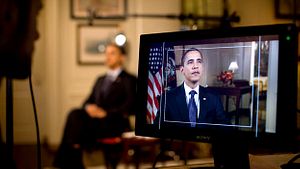U.S. National Security Adviser Susan Rice confirmed that President Obama’s next trip to Asia is slated for April 2014. The objective of the visit is to broadly reinforce U.S. ties across the Asia-Pacific region. She did not specify what countries he would visit.
The announcement clears the air for U.S. Asia-watchers after the government shutdown in October forced Obama to cancel his plans to attend the APEC summit where he would have brushed shoulders with everyone from ASEAN heads of states to Xi Jinping. The knee-jerk reaction then by the American media was declare the cancellation a tragic blow to the U.S. pivot and a major boon for Chinese influence. Talk of the pivot’s demise was greatly exaggerated in this case.
So what should the President do during his next trip to Asia (about which very little is currently known)? I’ve decided to offer a few big-picture pointers for what could be on the President’s potential agenda.
1. Double-down on the Trans-Pacific Partnership (TPP)
The TPP is probably the most significant on-going economic negotiation process in world politics at the moment. At stake is the participation of 40 percent of the world’s GDP in a free-trade regime of unprecedented size. It brings together a group of like-minded Pacific economies and liberalizes trade in a way that could increase the competitiveness of American firms in the Asia-Pacific region. The TPP also pointedly excludes China – something that makes it an appealing option for many Asian economies, like Japan, who fear an over-reliance on China and seek to establish credible hedging strategies.
The controversial TPP negotiations hit somewhat of a roadblock with Wikileaks’ latest revelations about the anti-consumer intellectual property clauses. The leaked draft demonstrates that there is still a long way to go for negotiations to conclude in a manner that could benefit the region at large. Obama should, and probably will, heavily feature the TPP in his next trip.
2. Reiterate the value of the 7th Fleet’s presence in the Pacific.
Despite the tragedy of Typhoon Haiyan, the United States’ response and diversion of naval resources towards Philippines shores has been an effective reminder around the region of the why letting the U.S. 7th fleet stick around in the long-run might be worth it.
Although not originally part of the U.S. playbook, China’s underwhelming and embarrassing response to the crisis can only reinforce this point.
In general, the pivot is as much about Southeast Asia as it is about East Asia – ASEAN could use some reassuring about the United States’ intentions in the region. Susan Rice, in her speech today, did mention that the U.S. effort in the Philippines represented a “broader pledge” to the rest of Asia.
3. Have a chat about ideas with Xi Jinping
Should Obama find himself in a room with Xi Jinping, he ought to engage in a friendly chat about ideas. Xi has been keen to push the idea of a “new type of great power relationship,” but the American response has been frigid. Obama has largely been silent on these matters. Obama shouldn’t acquiesce but should reiterate a vision for a future U.S.-China relationship where the two commit to resolving their differences peaceful, eschew unilateral conduct that brazenly alters the balance of power, and to increase cooperation on regional security matters. He should additionally praise the Third Plenum’s announcements on China’s transition to previously-unseen levels of market openness – and maybe seek clarification on the role of China’s new national security council.
I’m not going to go as far as to say the time has come for a fourth communiqué, but now that Xi Jinping has effectively consolidated his leadership and revealed his hand, Obama could do worse than clear the air on U.S. expectations about the imminent future of the world’s most important bilateral relationship.
4. Have a serious discussion with Shinzo Abe and Park Geun-Hye
The two U.S. allies in northeast Asia haven’t quite been getting along lately. Obama shouldn’t attempt to broker between allies – that’s a recipe for disaster – but he should reassure both Japan and South Korea about their standing with the United States as an ally.
Obama and Abe should discuss the latter’s vision for his country – if Japan is truly “back” as Abe claims, the implications for American foreign and security policy in East Asia are huge. Obama hasn’t seen a Japanese Prime Minister stick around for more than a year since before his days as a Senator. Abe is likely to stick around and his vision for Japan differs greatly from his DPJ predecessors whom the President might have gotten used to. Whatever else he may be, Abe is a man of grand visions and ideas for Japan’s role in Asia – Obama would do well to hear him out. The U.S.-Japan relationship could use some re-imagination before 2016.
In South Korea, Obama needs to reassure Park Geun-Hye of the on-going U.S. commitment to their alliance and review the North Korea situation (as is normal).
–
The above points are just a few among several more granular agenda items for the President in his next tour across Asia. They don’t acknowledge the possibility of a visit to New Delhi or Islamabad – both could be likely destinations as well. For the moment, East Asia seems to be the most likely venue.
Perceptions matter in international relations, and such high-level continental tours do more to reinforce a national idea and image than actual policy outcomes a lot of the time. Come April, the President will surely be expecting several difficult conversations with friends and rivals alike in Asia – above all, he needs to remove any doubts about whether the U.S. still sees Asia as its prime strategic focus.
Ankit Panda is Associate Editor of The Diplomat. Follow him on Twitter @nktpnd.

































